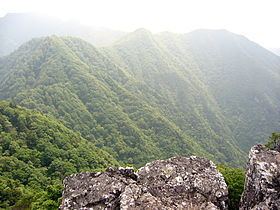Elevation 1,719 m | Easiest route Hiking | |
 | ||
Similar Mt Hachigyogatake, Mount Ōdaigahara, Mount Shakka, Gyojagaeridake, Mt Misen | ||
Pilgrimage to the mount omine 2013 3
Mount Ōmine (大峰山, Ōmine-san), is a sacred mountain in Nara, Japan, famous for its three tests of courage.
Contents
- Pilgrimage to the mount omine 2013 3
- Map of Ominesan Kamaishi Iwate Prefecture Japan
- 1999 shugendo omine mounts okugake pilgrimage with non japanese fellowship
- History
- Ban on women
- Tests of courage
- References
Map of Ominesan, Kamaishi, Iwate Prefecture, Japan
Officially known as Mount Sanjō (山上ヶ岳, Sanjō-ga-take), it is more popularly known as Mount Ōmine due to its prominence in the Ōmine mountain range. It is located in Yoshino-Kumano National Park in the Kansai region, Honshū, Japan.
The temple Ōminesanji, located at the top of the mountain, is the headquarters of the Shugendō sect of Japanese Buddhism and the entire mountain is part of a pilgrimage and training ground for the yamabushi.
1999 shugendo omine mounts okugake pilgrimage with non japanese fellowship
History
The monastery at Mount Ōmine was founded in the 8th century by En no Gyōja, as a home for his new religion of Shugendō. Shugendo literally means "the path of training and testing," and is based on the self-actualization of spiritual power in experiential form through challenging and rigorous ritualistic tests of courage and devotion known as shugyo.
During the Meiji period, in 1872 the imperial government forbade all "superstitious practices" including belief in folkloric creatures such as Yōkai and Yūrei, as well as gender bans on sacred mountains such as Mount Fuji and all of the rituals of Mount Ōmine. During this time the mountain was closed, and any Shugendo practices were carried on in secret. However, in 1945 the Japanese Culture Act repealed these edicts, and the mountain was opened again. Shugendō practicers were quick to reclaim the mountain and restore the traditions.
In 1964, Mountaineer/author Kyūya Fukada selected Mount Ōmine as number 91 of his 100 famous mountains in Japan. Fukuda's three criteria for the selection of 100 celebrated mountains was their physical grandeur, historical and spiritual significance to Japan, and its individuality, meaning it must have a unique shape, phenomenon or event associated with it. In 1980 an area of 36,000 ha in the region of Mount Ōmine and Mount Ōdaigahara was designated a UNESCO Man and the Biosphere Reserve.
In 2004, it was designated as an UNESCO World Heritage Site, as part of the "Sacred Sites and Pilgrimage Routes in the Kii Mountain Range". This selection was seen as ending the controversy surrounding the mountain's ban on women climbers, as it was given official approval by UNESCO.
Ban on women
Traditionally, women in Japan were not allowed to climb mountains sacred to the Shinto religions. While the origins of the traditions can only be guessed at, originally these areas were banned to unclean people, such as those who had recently had a death in the family or menstruating women, which was believed to be linked to Shinto concepts of impurity, specifically the "blood impurity" brought on by menstruation and childbirth.
Other sacred mountains had different traditions, such as segregating the sexes by season, allowing women to climb at some times and men to climb at others. It is believed that the reason for this ban was to remove thoughts of temptation from the Yamabushi monks who are supposed to practice the strict self-denial of a hermit in isolated mountain. Eventually the bans came to be called Nyonin Kekkai (女人結界) and toward women only.
Mount Ōmine is the headquarters of the Shugendō religion, an ascetic practice with a long tradition. Because of a decrease of ascetic practitioners in modern Japan, most Shugendō-related mountains are no longer used for mountain retreats and are now tourist attractions. Consequently, these sites removed their gender-restrictions and only Mount Ōmine remains.
Only Mount Sanjō has the ban on women. The Mount Inamura (稲村ヶ岳) section of Mount Ōmine is reserved for women and is often called Nyonin Ōmine (女人大峯), "Women's Ōmine". The holiest temple for the Shugendō religion is found at the Yamagaoka hill section, and a sign at the entrance to the mountain proclaims "No Women Admitted," in English and Japanese. (Mount Athos in Greece, an Orthodox Christian site, has a similar ban on women.) Mount Ōmine's prohibition is voluntary. There have been breaches every year by feminist activists but no trespassing charge has ever been filed. Every time the boundary is breached, the temple and the local community issue a request for people to respect their religion and tradition.
The ban has been challenged many times but without success. Supporters note that sexual segregation does not equal sexual discrimination. Supporters also state that the ban has an unbroken, 1,300-year tradition. Mount Ōmine's designation as a World Heritage site by UNESCO was seen by critics of the ban to have given the gender ban a stamp of approval.
Tests of courage
There are three shugyo on Mount Ōmine, each said to strengthen the spiritual power of the challenger. Climbers not wishing to take the tests can easily walk around them.
